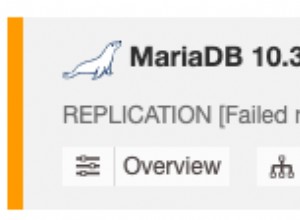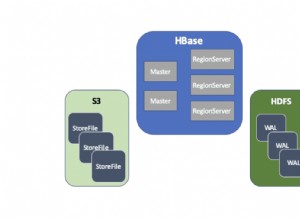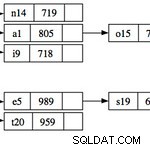En MongoDB, el $not El operador de canalización de agregación evalúa un valor booleano y devuelve el valor booleano opuesto.
En otras palabras, cuando el booleano se evalúa como true , el $not el operador devuelve false . Y cuando el booleano se evalúa como false , el $not el operador devuelve true .
Ejemplo
Supongamos que tenemos una colección llamada tests con los siguientes documentos:
{ "_id" : 1, "data" : true }
{ "_id" : 2, "data" : false }
Esto es lo que sucede cuando aplicamos $not a los data campo de cada documento:
db.test.aggregate(
[
{ $match: { _id: { $in: [ 1, 2 ] } } },
{ $project: {
_id: 0,
data: 1,
result: { $not: [ "$data" ] } }
}
]
)Resultado:
{ "data" : true, "result" : false }
{ "data" : false, "result" : true }
Podemos ver que $not devolvió el opuesto de cada valor booleano.
Valores cero, nulos e indefinidos
El $not el operador evalúa 0 , null y undefined como false – lo que significa que devuelve true .
Supongamos que tenemos los siguientes documentos:
{ "_id" : 3, "data" : 0 }
{ "_id" : 4, "data" : null }
{ "_id" : 5, "data" : undefined }
Esto es lo que sucede cuando aplicamos $not :
db.test.aggregate(
[
{ $match: { _id: { $in: [ 3, 4, 5 ] } } },
{ $project: {
_id: 0,
data: 1,
result: { $not: [ "$data" ] } }
}
]
)Resultado:
{ "data" : 0, "result" : true }
{ "data" : null, "result" : true }
{ "data" : undefined, "result" : true }
Como era de esperar, todos devolvieron true (lo que significa que evaluaron como false .
Todos los demás valores
El $not operador todos los demás valores como true – lo que significa que devuelve false .
Supongamos que tenemos los siguientes documentos:
{ "_id" : 6, "data" : [ true ] }
{ "_id" : 7, "data" : [ false ] }
{ "_id" : 8, "data" : 5 }
{ "_id" : 9, "data" : "Bat" }
{ "_id" : 10, "data" : ISODate("2021-01-03T23:30:15.100Z") }
Esto es lo que sucede cuando aplicamos $not :
db.test.aggregate(
[
{ $match: { _id: { $in: [ 6, 7, 8, 9, 10 ] } } },
{ $project: {
_id: 0,
data: 1,
result: { $not: [ "$data" ] } }
}
]
)Resultado:
{ "data" : [ true ], "result" : false }
{ "data" : [ false ], "result" : false }
{ "data" : 5, "result" : false }
{ "data" : "Bat", "result" : false }
{ "data" : ISODate("2021-01-03T23:30:15.100Z"), "result" : false }
Todos devuelven false (lo que significa que se evalúan como true ).
Campos faltantes
Aplicando $not a un campo que no existe se evalúa como false (lo que significa que devuelve true ).
Supongamos que tenemos el siguiente documento:
{ "_id" : 11 }
Y aplicamos $not a eso:
db.test.aggregate(
[
{ $match: { _id: { $in: [ 11 ] } } },
{ $project: {
_id: 0,
data: 1,
result: { $not: [ "$data" ] } }
}
]
)Resultado:
{ "result" : true } Negar otro operador
El $not El operador puede usarse para negar la salida booleana de otro operador.
Supongamos que tenemos una colección llamada pets con los siguientes documentos:
{ "_id" : 1, "name" : "Wag", "type" : "Dog", "weight" : 20 }
{ "_id" : 2, "name" : "Bark", "type" : "Dog", "weight" : 10 }
{ "_id" : 3, "name" : "Meow", "type" : "Cat", "weight" : 7 }
{ "_id" : 4, "name" : "Scratch", "type" : "Cat", "weight" : 8 }
{ "_id" : 5, "name" : "Bruce", "type" : "Kangaroo", "weight" : 100 }
{ "_id" : 6, "name" : "Hop", "type" : "Kangaroo", "weight" : 130 }
{ "_id" : 7, "name" : "Punch", "type" : "Kangaroo", "weight" : 200 }
{ "_id" : 8, "name" : "Snap", "type" : "Cat", "weight" : 12 }
{ "_id" : 9, "name" : "Ruff", "type" : "Dog", "weight" : 30 }
Podemos usar $not junto con digamos, $gt para evaluar el campo de peso:
db.pets.aggregate(
[
{ $project: {
_id: 0,
name: 1,
weight: 1,
result: { $not: [ { $gt: [ "$weight", 100 ] } ] } }
}
]
)Resultado:
{ "name" : "Wag", "weight" : 20, "result" : true }
{ "name" : "Bark", "weight" : 10, "result" : true }
{ "name" : "Meow", "weight" : 7, "result" : true }
{ "name" : "Scratch", "weight" : 8, "result" : true }
{ "name" : "Bruce", "weight" : 100, "result" : true }
{ "name" : "Hop", "weight" : 130, "result" : false }
{ "name" : "Punch", "weight" : 200, "result" : false }
{ "name" : "Snap", "weight" : 12, "result" : true }
{ "name" : "Ruff", "weight" : 30, "result" : true }
Para reiterar esto, aquí está de nuevo, pero esta vez mostramos un campo para el $gt resultados, así como el campo para no $gt resultados:
db.pets.aggregate(
[
{ $project: {
_id: 0,
weight: 1,
gt: { $gt: [ "$weight", 100 ] },
notGt: { $not: [ { $gt: [ "$weight", 100 ] } ] } }
}
]
)Resultado:
{ "weight" : 20, "gt" : false, "notGt" : true }
{ "weight" : 10, "gt" : false, "notGt" : true }
{ "weight" : 7, "gt" : false, "notGt" : true }
{ "weight" : 8, "gt" : false, "notGt" : true }
{ "weight" : 100, "gt" : false, "notGt" : true }
{ "weight" : 130, "gt" : true, "notGt" : false }
{ "weight" : 200, "gt" : true, "notGt" : false }
{ "weight" : 12, "gt" : false, "notGt" : true }
{ "weight" : 30, "gt" : false, "notGt" : true }
Cada vez $gt resultó en true , el $not el operador lo cambió a false . Y cada vez $gt resultó en false , $not lo cambió a true .




